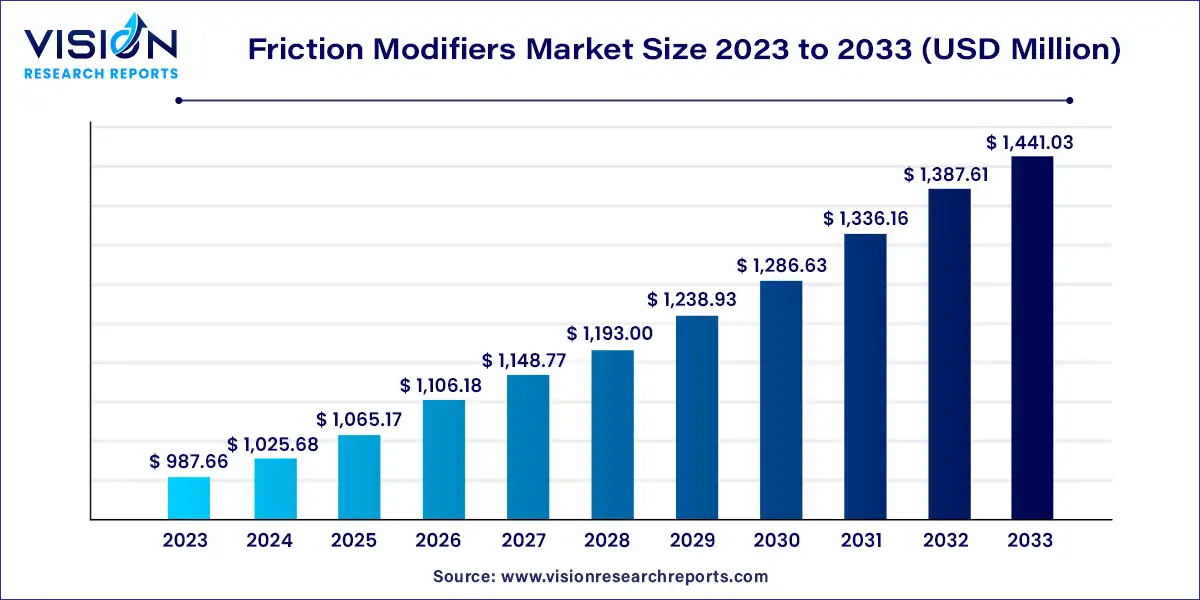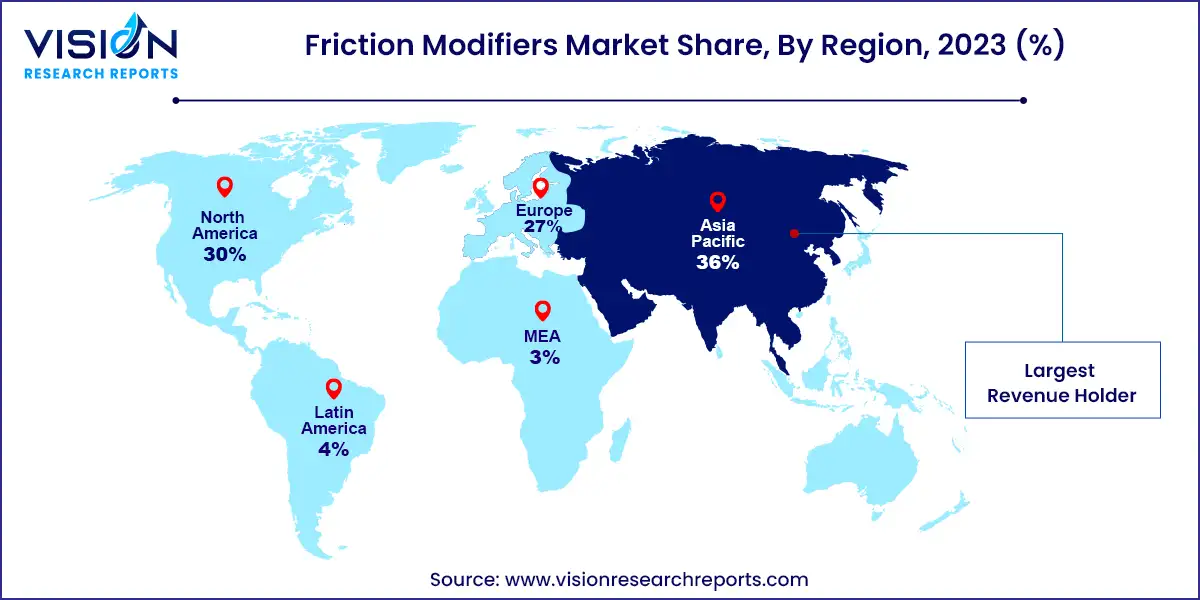The global friction modifiers market size was valued at USD 987.66 million in 2023 and it is predicted to surpass around USD 1,441.03 million by 2033 with a CAGR of 3.85% from 2024 to 2033. The global market for friction modifiers is experiencing robust growth, driven by increasing demand across diverse end-user industries such as automotive, aerospace, and industrial manufacturing. Friction modifiers play a critical role in enhancing the efficiency and longevity of machinery by reducing frictional resistance between surfaces in contact.

The friction modifiers market is experiencing robust growth driven by an increasing demand across automotive, aerospace, and industrial sectors is bolstering market expansion. These additives play a crucial role in enhancing efficiency and longevity by reducing frictional resistance between surfaces, thereby improving fuel efficiency and lowering maintenance costs. Technological advancements in lubrication systems and a shift towards eco-friendly additives due to stringent environmental regulations are also contributing to market growth. Moreover, innovations in synthetic and bio-based friction modifiers are catering to sustainability trends, further fueling market expansion.
Asia Pacific held a dominant revenue share of 36% in 2023, leading the global market. This region continues to drive global growth, fueled by robust automotive production, particularly in China, the world's largest automobile producer.
| Attribute | Asia Pacific |
| Market Value | USD 355.55 Million |
| Growth Rate | 3.85% CAGR |
| Projected Value | USD 518.77 Million |
China's friction modifiers market is experiencing significant expansion, driven by its leadership in automotive manufacturing, which has a profound impact on lubricant consumption and, consequently, the demand for friction modifier additives.
North America boasts a strong industrial presence in automotive, aerospace, and manufacturing sectors, all substantial consumers of friction modifiers. Technological advancements in the automotive industry have propelled market growth in this region, with increased vehicle production directly influencing global demand.

Europe anticipates increased demand for friction modifiers due to rising automotive production driven by consumer demand for fuel-efficient vehicles. Moreover, the shift toward electrification in road passenger transport, supported by national policies aimed at reducing carbon and particulate emissions, is expected to become increasingly significant in the coming years.
The commercial vehicle segment led the market with a substantial revenue share of 65% in 2023. The growing sales of commercial vehicles have driven up the consumption of lubricants, thereby increasing the demand for friction modifiers. Particularly in transportation lubricants, which are crucial for commercial vehicles, friction modifiers are expected to see significant growth.
In passenger vehicles, the application of friction modifiers plays a crucial role in enhancing fuel efficiency, reducing friction, and addressing environmental concerns. This aligns well with industry trends focused on sustainability and performance improvement, underscoring the importance of friction modifiers in this segment. With the rising production volumes of passenger cars and the booming automotive industry, the demand for friction modifiers in the global market is further amplified, emphasizing the critical role of the passenger vehicles segment.
Organic friction modifiers dominated the market with a significant revenue share of 58% in 2023. These modifiers, derived from naturally occurring or synthetic organic compounds, have gained considerable traction due to their ability to form a protective boundary film on metal surfaces, effectively reducing friction and wear.
Organic friction modifiers such as fatty acids, esters, and amides offer superior lubrication properties and find extensive use in automotive and industrial applications. Their environmentally friendly nature and compatibility with a wide range of base oils make them the preferred choice for lubricant formulations aimed at reducing energy consumption and enhancing equipment durability.
In contrast, inorganic friction modifiers are derived from mineral-based compounds and metallic salts. These additives alter the surface properties of metal components, thereby reducing friction and wear. Inorganic options like molybdenum disulfide and graphite provide excellent stability at high temperatures and exceptional load-carrying capacity, making them ideal for heavy-duty applications such as industrial gear oils and metalworking fluids. Their ability to withstand extreme operating conditions and provide long-lasting lubrication solutions positions them as essential components in high-performance lubricants across various industrial sectors.
By Type
By Application
By Region
Chapter 1. Introduction
1.1. Research Objective
1.2. Scope of the Study
1.3. Definition
Chapter 2. Research Methodology
2.1. Research Approach
2.2. Data Sources
2.3. Assumptions & Limitations
Chapter 3. Executive Summary
3.1. Market Snapshot
Chapter 4. Market Variables and Scope
4.1. Introduction
4.2. Market Classification and Scope
4.3. Industry Value Chain Analysis
4.3.1. Raw Material Procurement Analysis
4.3.2. Sales and Distribution Channel Analysis
4.3.3. Downstream Buyer Analysis
Chapter 5. COVID 19 Impact on Friction Modifiers Market
5.1. COVID-19 Landscape: Friction Modifiers Industry Impact
5.2. COVID 19 - Impact Assessment for the Industry
5.3. COVID 19 Impact: Global Major Government Policy
5.4. Market Trends and Opportunities in the COVID-19 Landscape
Chapter 6. Market Dynamics Analysis and Trends
6.1. Market Dynamics
6.1.1. Market Drivers
6.1.2. Market Restraints
6.1.3. Market Opportunities
6.2. Porter’s Five Forces Analysis
6.2.1. Bargaining power of suppliers
6.2.2. Bargaining power of buyers
6.2.3. Threat of substitute
6.2.4. Threat of new entrants
6.2.5. Degree of competition
Chapter 7. Competitive Landscape
7.1.1. Company Market Share/Positioning Analysis
7.1.2. Key Strategies Adopted by Players
7.1.3. Vendor Landscape
7.1.3.1. List of Suppliers
7.1.3.2. List of Buyers
Chapter 8. Global Friction Modifiers Market, By Type
8.1. Friction Modifiers Market, by Type, 2024-2033
8.1.1. Organic
8.1.1.1. Market Revenue and Forecast (2021-2033)
8.1.2. Inorganic
8.1.2.1. Market Revenue and Forecast (2021-2033)
Chapter 9. Global Friction Modifiers Market, By Application
9.1. Friction Modifiers Market, by Application, 2024-2033
9.1.1. Commercial Vehicles
9.1.1.1. Market Revenue and Forecast (2021-2033)
9.1.2. Passenger Vehicles
9.1.2.1. Market Revenue and Forecast (2021-2033)
9.1.3. Others
9.1.3.1. Market Revenue and Forecast (2021-2033)
Chapter 10. Global Friction Modifiers Market, Regional Estimates and Trend Forecast
10.1. North America
10.1.1. Market Revenue and Forecast, by Type (2021-2033)
10.1.2. Market Revenue and Forecast, by Application (2021-2033)
10.1.3. U.S.
10.1.3.1. Market Revenue and Forecast, by Type (2021-2033)
10.1.3.2. Market Revenue and Forecast, by Application (2021-2033)
10.1.4. Rest of North America
10.1.4.1. Market Revenue and Forecast, by Type (2021-2033)
10.1.4.2. Market Revenue and Forecast, by Application (2021-2033)
10.2. Europe
10.2.1. Market Revenue and Forecast, by Type (2021-2033)
10.2.2. Market Revenue and Forecast, by Application (2021-2033)
10.2.3. UK
10.2.3.1. Market Revenue and Forecast, by Type (2021-2033)
10.2.3.2. Market Revenue and Forecast, by Application (2021-2033)
10.2.4. Germany
10.2.4.1. Market Revenue and Forecast, by Type (2021-2033)
10.2.4.2. Market Revenue and Forecast, by Application (2021-2033)
10.2.5. France
10.2.5.1. Market Revenue and Forecast, by Type (2021-2033)
10.2.5.2. Market Revenue and Forecast, by Application (2021-2033)
10.2.6. Rest of Europe
10.2.6.1. Market Revenue and Forecast, by Type (2021-2033)
10.2.6.2. Market Revenue and Forecast, by Application (2021-2033)
10.3. APAC
10.3.1. Market Revenue and Forecast, by Type (2021-2033)
10.3.2. Market Revenue and Forecast, by Application (2021-2033)
10.3.3. India
10.3.3.1. Market Revenue and Forecast, by Type (2021-2033)
10.3.3.2. Market Revenue and Forecast, by Application (2021-2033)
10.3.4. China
10.3.4.1. Market Revenue and Forecast, by Type (2021-2033)
10.3.4.2. Market Revenue and Forecast, by Application (2021-2033)
10.3.5. Japan
10.3.5.1. Market Revenue and Forecast, by Type (2021-2033)
10.3.5.2. Market Revenue and Forecast, by Application (2021-2033)
10.3.6. Rest of APAC
10.3.6.1. Market Revenue and Forecast, by Type (2021-2033)
10.3.6.2. Market Revenue and Forecast, by Application (2021-2033)
10.4. MEA
10.4.1. Market Revenue and Forecast, by Type (2021-2033)
10.4.2. Market Revenue and Forecast, by Application (2021-2033)
10.4.3. GCC
10.4.3.1. Market Revenue and Forecast, by Type (2021-2033)
10.4.3.2. Market Revenue and Forecast, by Application (2021-2033)
10.4.4. North Africa
10.4.4.1. Market Revenue and Forecast, by Type (2021-2033)
10.4.4.2. Market Revenue and Forecast, by Application (2021-2033)
10.4.5. South Africa
10.4.5.1. Market Revenue and Forecast, by Type (2021-2033)
10.4.5.2. Market Revenue and Forecast, by Application (2021-2033)
10.4.6. Rest of MEA
10.4.6.1. Market Revenue and Forecast, by Type (2021-2033)
10.4.6.2. Market Revenue and Forecast, by Application (2021-2033)
10.5. Latin America
10.5.1. Market Revenue and Forecast, by Type (2021-2033)
10.5.2. Market Revenue and Forecast, by Application (2021-2033)
10.5.3. Brazil
10.5.3.1. Market Revenue and Forecast, by Type (2021-2033)
10.5.3.2. Market Revenue and Forecast, by Application (2021-2033)
10.5.4. Rest of LATAM
10.5.4.1. Market Revenue and Forecast, by Type (2021-2033)
10.5.4.2. Market Revenue and Forecast, by Application (2021-2033)
Chapter 11. Company Profiles
11.1. INX International Ink Co.
11.1.1. Company Overview
11.1.2. Product Offerings
11.1.3. Financial Performance
11.1.4. Recent Initiatives
11.2. Kornit DigitalMarabu GmbH & Co. KG
11.2.1. Company Overview
11.2.2. Product Offerings
11.2.3. Financial Performance
11.2.4. Recent Initiatives
11.3. Nazdar
11.3.1. Company Overview
11.3.2. Product Offerings
11.3.3. Financial Performance
11.3.4. Recent Initiatives
11.4. Nutec digital Ink
11.4.1. Company Overview
11.4.2. Product Offerings
11.4.3. Financial Performance
11.4.4. LTE Scientific
11.5. Sensient Imaging Technologies
11.5.1. Company Overview
11.5.2. Product Offerings
11.5.3. Financial Performance
11.5.4. Recent Initiatives
11.6. Siegwerk Druckfarben AG & Co. KgaA
11.6.1. Company Overview
11.6.2. Product Offerings
11.6.3. Financial Performance
11.6.4. Recent Initiatives
11.7. Sun Chemical
11.7.1. Company Overview
11.7.2. Product Offerings
11.7.3. Financial Performance
11.7.4. Recent Initiatives
11.8. Toyo Ink Co., Ltd.
11.8.1. Company Overview
11.8.2. Product Offerings
11.8.3. Financial Performance
11.8.4. Recent Initiatives
11.9. Wikoff Color Corporation
11.9.1. Company Overview
11.9.2. Product Offerings
11.9.3. Financial Performance
11.9.4. Recent Initiatives
11.10. Whitmore Manufacturing, LLC.
11.10.1. Company Overview
11.10.2. Product Offerings
11.10.3. Financial Performance
11.10.4. Recent Initiatives
Chapter 12. Research Methodology
12.1. Primary Research
12.2. Secondary Research
12.3. Assumptions
Chapter 13. Appendix
13.1. About Us
13.2. Glossary of Terms
 Cross-segment Market Size and Analysis for
Mentioned Segments
Cross-segment Market Size and Analysis for
Mentioned Segments
 Additional Company Profiles (Upto 5 With No Cost)
Additional Company Profiles (Upto 5 With No Cost)
 Additional Countries (Apart From Mentioned Countries)
Additional Countries (Apart From Mentioned Countries)
 Country/Region-specific Report
Country/Region-specific Report
 Go To Market Strategy
Go To Market Strategy
 Region Specific Market Dynamics
Region Specific Market Dynamics Region Level Market Share
Region Level Market Share Import Export Analysis
Import Export Analysis Production Analysis
Production Analysis Others
Others